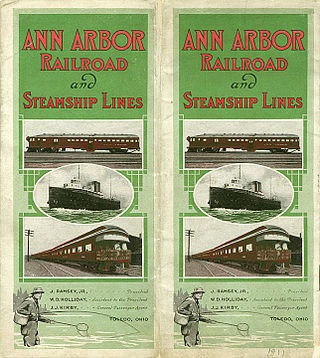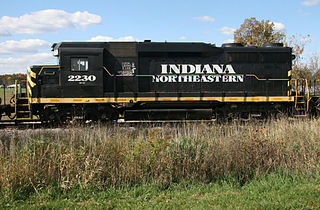The Detroit, Toledo and Ironton Railroad operated from 1905 to 1983 between its namesake cities of Detroit, Michigan, and Ironton, Ohio, via Toledo. At the end of 1970, it operated 478 miles of road on 762 miles of track; that year it carried 1,244 million ton-miles of revenue freight.

The Ann Arbor Railroad was an American railroad that operated between Toledo, Ohio, and Elberta and Frankfort, Michigan with train ferry operations across Lake Michigan. In 1967 it reported 572 million net ton-miles of revenue freight, including 107 million in "lake transfer service"; that total does not include the 39-mile subsidiary Manistique and Lake Superior Railroad.

The Michigan Central Railroad was originally chartered in 1832 to establish rail service between Detroit, Michigan, and St. Joseph, Michigan. The railroad later operated in the states of Michigan, Indiana, and Illinois in the United States and the province of Ontario in Canada. After about 1867 the railroad was controlled by the New York Central Railroad, which later became part of Penn Central and then Conrail. After the 1998 Conrail breakup, Norfolk Southern Railway now owns much of the former Michigan Central trackage.

The Great Lakes Central Railroad is an American shortline railroad, operating in the state of Michigan. It was originally called the Tuscola and Saginaw Bay Railway, which was formed on August 26, 1977, to operate over former Penn Central lines from Millington to Munger, and from Vassar to Colling. TSBY's name was derived from the three counties it operated in: Tuscola, Saginaw and Bay.
The Austin Area Terminal Railroad was a short-line terminal railroad headquartered in Round Rock, Texas.

The Alabama Southern Railroad is a class III railroad that operates in the southern United States. The ABS is one of several short line railroads owned by Watco. The railroad operates an 85-mile (137 km) line leased from the Canadian Pacific Kansas City (CPKC). It began operating in 2005.
The Lincoln Secondary is a railroad line owned and operated by Conrail in the U.S. state of Michigan as part of its Conrail Shared Assets Operations.

Railroads have been vital in the history of the population and trade of rough and finished goods in the state of Michigan. While some coastal settlements had previously existed, the population, commercial, and industrial growth of the state further bloomed with the establishment of the railroad.

The Indiana Northeastern Railroad is a Class III short line freight railroad operating on nearly 130 miles (210 km) in southern lower Michigan, northeast Indiana and northwest Ohio. The Indiana Northeastern Railroad Company began operations in December 1992 and is an independent privately owned company. As of 2017 the railroad hauled more than 7,000 carloads per year. Commodities moved by the railroad include corn, soybeans, wheat and flour. It also handles plastics, fiberboard, aluminum, copper, coal, perlite, stone, lumber, glass, rendering products, as well as agricultural fertilizers and chemicals.

The Indiana & Ohio Railway is an American railroad that operates 570 miles (920 km) of track in Ohio, southern Michigan, and parts of southeastern Indiana. It is owned and operated by Genesee & Wyoming, who acquired the railroad in the 2012 purchase of RailAmerica.
The Lenawee County Railroad was a shortline railroad in the state of Michigan. It was incorporated in 1977 to operate a former Penn Central line serving Adrian, Michigan, and eventually operated 30 miles (48 km) of lines in Lenawee County, Michigan. The company ceased operations in 1990. The Adrian and Blissfield Rail Road, founded in 1991, operates over some of the company's lines.
The following is a brief history of the North American rail system, mainly through major changes to Class I railroads, the largest class by operating revenue.
Wyandotte Terminal Railroad was incorporated in the State of Michigan, United States of America, on September 14, 1904. It ceased operations as a railroad in 1982.
The Michigan Interstate Railway was formed on August 27, 1977, to operate the Ann Arbor Railroad main line from Toledo, Ohio, to Elberta, Michigan. It succeeded Conrail as the designated operator of the line; Conrail had operated the line since 1976, following the Ann Arbor Railroad's bankruptcy.
The Kalamazoo and White Pigeon Railroad (K&WP) was a shortline railroad in the U.S. state of Michigan. It was incorporated in 1869 and consolidated with the New York Central Railroad in 1914. Its line ran from Kalamazoo, Michigan, to Constantine, Michigan.
The West Virginia Secondary is a rail line that connects Columbus, Ohio, to Charleston, West Virginia, and beyond to the Gauley River valley, ending in Enon, West Virginia. The line is about 250 miles long. It crosses the Ohio River over the Point Pleasant Rail Bridge.
The Morenci branch or Fayette branch was a railway line in the states of Michigan and Ohio. It ran 25.21 miles (40.57 km) from Grosvenor, near Blissfield, Michigan, to Fayette, Ohio. It was built by the Chicago and Canada Southern Railway in 1872 as part of abortive attempt to construct a new through route between Southern Ontario and Chicago. The branch became part of the Lake Shore and Michigan Southern Railway system, and from there passed on to the New York Central Railroad and Penn Central. Following the Penn Central's bankruptcy, the state of Michigan acquired the line and abandoned it in 1991.

The main line of Ann Arbor Railroad is a partially-abandoned railway line in the states of Michigan and Ohio. It was constructed between 1874 and 1897 by the Ann Arbor Railroad and its predecessors, and constituted that company's main line. At its fullest extent it ran 292 miles (470 km) from Toledo, Ohio, on Lake Erie, to Frankfort, Michigan, on Lake Michigan. A train ferry service operated across Lake Michigan to Wisconsin. The original Ann Arbor Railroad went bankrupt in 1976, and ownership of the line is now split between the state of Michigan and two short-line railroads: the Ann Arbor Railroad and the Huron and Eastern Railway. The northern end of the line is now near Yuma, Michigan.







